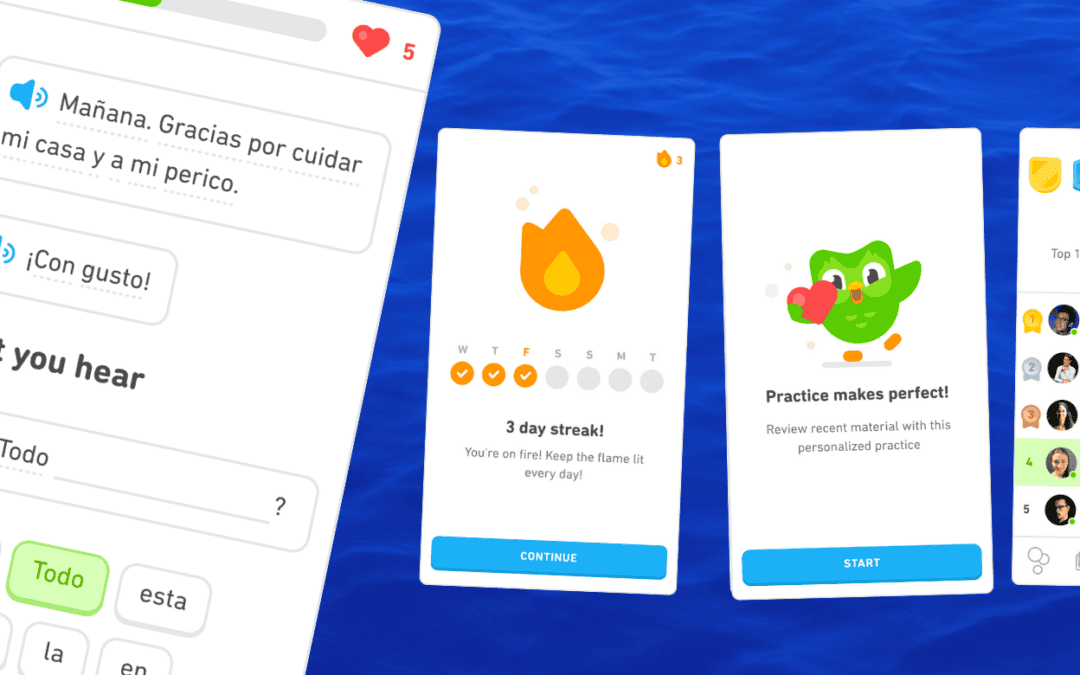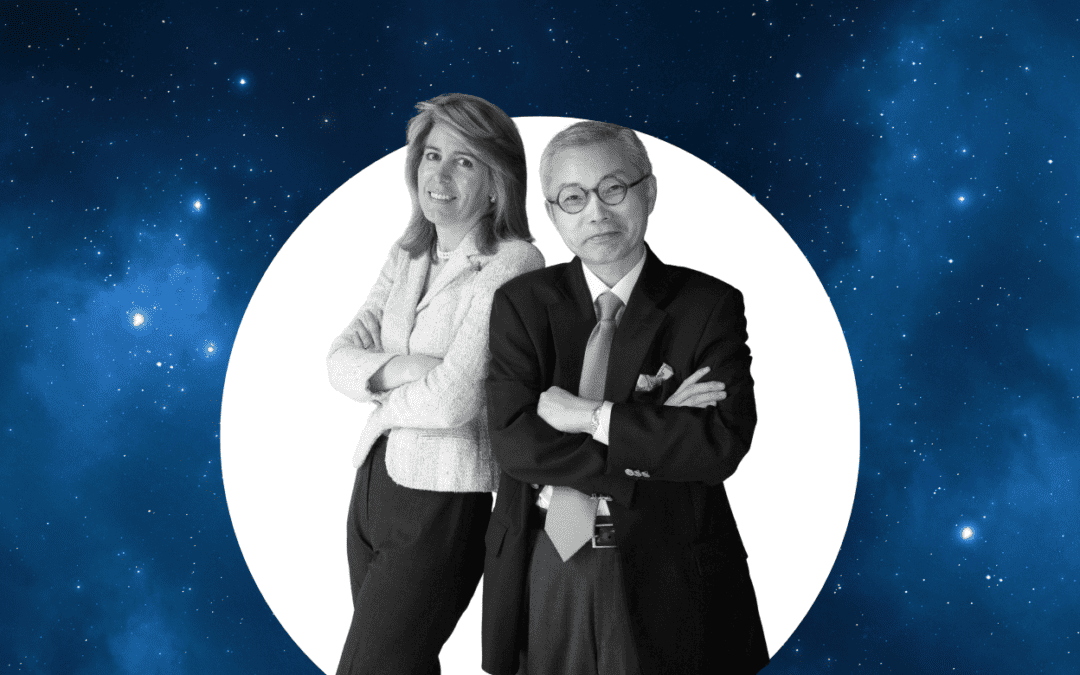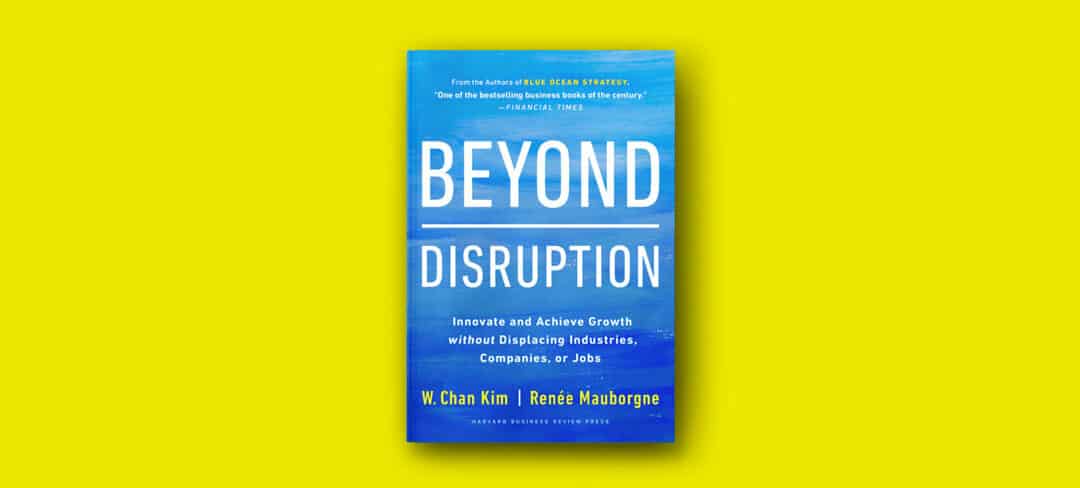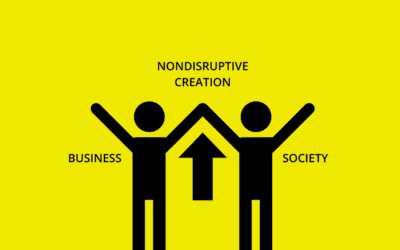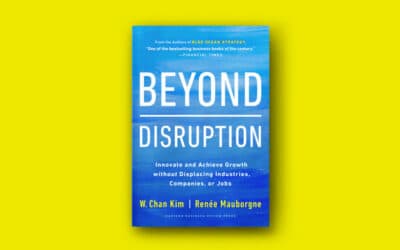We recently had the opportunity to interview Shawn Busse, CEO of Kinesis a Portland marketing firm founded in 2000. When his company started to feel the impact of the downturn in 2009, Shawn turned to Blue Ocean Strategy to change the course of the company and steer it towards uncontested market space. As Shawn explained, “I realized that our existing business model was not highly remarkable – while we created great work, we also had plenty of competitors producing similar work. It forced us to ask some tough questions and completely reinvent our business model.”
This blue ocean journey has allowed Kinesis to enjoy tremendous growth– including becoming one of the Portland Business Journal’s 100 fastest-growing private companies three years in a row, and being selected as a 2015 Portland Business Journal Small Business & Innovation Award honoree.
From a functional perspective, Kinesis is an outsourced marketing company for small businesses that are anywhere from 10 to 100 employees. Specifically, it serves businesses that have service at the center of their offering – such as professional consulting firms or companies that actually make products as an extension of the service they provide (like customizing a product).
A CEO’s advice on how to succeed despite tough times (interview)
Kim & Mauborgne: Effective branding rests on bringing creativity to bear on what companies do. How would you describe the branding industry and what are the challenges Kinesis faced?
Shawn Busse: As the recession brought to light, if ever there were a red ocean market space it would be in the branding arena! It is incredibly crowded. Branding agencies are everywhere, and at all different price points – from a freelancer to help with your logo, all the way up to global branding agencies with huge staff, designed to serve Fortune500 companies.
If ever there were a red ocean market space it would be in the branding arena!
Before the recession, we were riding the wave of a good economy – people had money to spend and work was just coming in. We had no idea how crowded the market was or that it was even bad to be in a red ocean. Kinesis has been around since 2000 – which is pretty long, considering marketing firms usually come and go with the economy.
I would say that for the first ten years, we were fine with being a branding agency that helps companies to communicate how they are exceptional, and to visually demonstrate their uniqueness in the marketplace.
But the recession really highlighted how red that ocean was, and also how customers do not necessarily want to pay for that kind of work when times are tough. So we faced two huge challenges: a very crowded marketplace, and doing work we discovered was seen as just a “nice-to-have” only when the economy is strong.
K&M: What inspired you to apply blue ocean strategy in 2009?
SB: Right around 2009, I started thinking the business model of the industry is not all it is cracked up to be. I read a number of books during that time, including Blue Ocean Strategy. I quickly realized my company was in a red ocean. This happened almost at the same time we started to feel the impact of the downturn.
As I started to analyse our business model, I realized we were fighting these huge players that we were never going to be – and principally using the same strategic approach, just on a smaller scale. That is when I knew we had to change the business 180 degrees. To be in an overcrowded industry – and do the same things as the large guys do but with a tiny fraction of the resources – is not smart. Blue ocean strategy crystallized this for me, and gave me a language system to understand that we were in a red ocean and we needed to get out and create new market space.
Blue ocean strategy gave me a language system to understand that we were in a red ocean and we needed to get out and create new market space.
K&M: Blue ocean strategy is about creating new demand and looking to noncustomers of the industry. How has Kinesis’ strategy shifted in this regard?
SB: We used to work with marketers within a company of any size. We worked with anybody from small start-ups to global players, and marketers would ask us to help them with their branding initiative. We were competing for these projects with other agencies and sometimes there were requests for proposals (RFPs), which as we all know are costly and time-consuming to produce. One day, that work effectively stopped. It was like somebody just turned off the phone. So, in a few months, we went from being a healthy company to major layoffs. We went down to no staff at all. It was emotionally tough, nobody likes to lay people off.
I started asking questions about the business model and the existing market space, and I realized we needed to create something different.
As I analysed the industry, I saw that all of our customers (who were marketing managers or marketing coordinators within companies) were either being fired or had their budget eliminated.
But if marketing is supposed to bring customers to your door, and supposed to help you grow revenues, why were these marketing functions and the people in them being disempowered?
The more I asked this question, the more I realized that there was a fundamental problem with marketing: business owners were not able to see how marketing is connected to the profit and loss statement.
That was the beginning of this journey of realization. This disconnection between executives and marketing was actually pretty profound, and the blue ocean opportunity we saw was to close that gap. In order to do that we shifted our buyer group from marketing managers to the heads of the companies. We wanted to build a place where we were actually just working with the owner of the company, and the intermediary was eliminated.

K&M: Shifting the buyer group the industry focuses on is one of the six paths to new market space. As a small company without a big staff, how did you apply blue ocean strategy? And who were the noncustomers you focused on?
SB: After thinking through blue ocean strategy, it was clear we had to aim to operate in a marketplace where there is little to no competition – and to create an offering that had not existed before. That, in itself, fundamentally shifted our thought process. It leads us to ask what to eliminate, reduce, raise, and create to stand apart while having lower costs.
The idea was to create a marketing mechanism that is a lot like an in-house employee, but without actually being on a company’s payroll and still bringing so much more to the table. Typically the branding agency industry focuses on going upstream to work with bigger and bigger companies. However, that completely ignores a far larger share of the economy, which are growing businesses of 1 to 10 million in sales. Interestingly, this is often thought of as a niche market – though the number of companies here is far larger than the market space of large companies (which most in the industry focuses on).
Instead of fighting to capture a larger share of the existing industry space, blue ocean strategy gave me the insight to focus on these noncustomers.
I felt like I could create a space that other competitors were not going into, for a number of reasons. It is hard to operate in that space and make money using the existing industry business model. You have to be able to systematize many things and create a transferable process around clients so you are efficient.
K&M: That is exactly what Salesforce.com did to unlock a blue ocean in the customer relationship management software industry. Instead of focusing on the existing customers of the industry, namely big companies, where competitors were fighting in a red ocean, it shifted its focus and looked to what we call second tier noncustomers – all those companies that had refused the industry – which, as in your case, were also the small and mid-size players. So how did you do it?
SB: I did not do it myself. I think what I brought to the table was the acknowledgement of the problem. To unlock this new market space I started to engage employees, and my co-owner and I began to carve out time to think about this.
Don’t wait until you are irrelevant before you start thinking about creating your blue ocean.
That is when we also realized that the way the industry approaches growth and people has a costly dark side to it. The branding industry is very opportunistic – players see a big pile of money on the table and jump on it. And they will do it over and over again, at the expense of their business model. As a consequence, they often grow very fast, grabbing whatever project they can.
The downside of that, in my opinion, is that you create an unsustainable work environment – hiring people like crazy but not making them part of the culture, and so they just feel like cogs in a machine. Then you get to that 60 hours-a-week burn-out system. These agencies can grow from 20 to 50 people, and often, if they lose that big client can be firing 20 people.
Since our business is a service business at its core, the value our people bring to the table for every client is paramount. This meant we could not follow the industry trend of rapidly scaling up and scaling down the people we employ. As a small company, we could not attract and retain really high-quality talent that way. So how could we provide this to clients while also aiming for low costs, which is the essence of blue ocean strategy? That gave us the idea to change who we seek to hire, and the people proposition of our company.
We now manage growth to ensure a concept of sustainability, so that our employees stay with us for the long term. I probably leave some short-term profit on the table as a result. I know I do. Because running after piles cash, we decided, was not a strategy that ultimately brings value to clients or to our people.
A services businesses biggest problem is cash flow; if they sell more and more services they can actually grow themselves into bankruptcy.
Regarding the way we hire…we wanted to bring on people who can add a lot of marketing and strategic value to small and mid-size companies. So my idea was to create a workplace with reasonable work hours, which would attract a type of employee who is engaged because he/she wants to be part of this sustainable organisation. We set out to create a purpose-driven workplace that allows people to have lives, careers, and families.
Nothing about Kinesis is the norm. The norm in most agencies is to come to work for 60-80 hours a week and then burn-out after 2 or 3 years. So, part of our strategy was offering a different product to noncustomer, but the other part was to attract employees for the long term. Retention is really expensive if you do not get it right, and turnover costs just as much money. I am now attacking the cost through a different angle than the industry. I am attacking it from: how do I keep employees so I do not have a high turnover cost, and how do I attract high-quality talent who value quality of life over salary?
K&M: Can you further elaborate on how your offering in this new market space has changed as a result of blue ocean thinking?
SB: As I mentioned, we changed the buyer group that Kinesis focuses on from the industry’s go-to buyer group – marketing managers – to owners. Today we do not work with marketing people that are looking to do a project and then be done. We do not touch any of that work. We only work with leaders of companies, who occasionally have a marketing resource internally – but generally, we are leading the strategic planning process and communicate with the owner.
As part of that, we shifted from competing over the existing customers of the industry – that is, the large accounts the industry typically fights over – and now focus on small and mid-size companies, the once-noncustomers of the industry.
The way we achieved differentiation and low costs in this new market space (beyond the crucial people element I just touched on) are the strategic processes we bring to clients – integrating concepts like blue ocean strategy or Rockefeller Habits, and creating a systematic Marketing Blueprint tool. We are meaningfully different than anything else out there, and we are founded on proven tools and systems. We now have transferable marketing processes which allow us to deliver high value at lower costs to create a win for our clients and for our company.I should take a moment to elaborate on an important concept around “productizing services.” When I examined the financial model of a branding agency I realized it has the same problem as most service businesses. Namely, that you are paid after delivering services. As a company grows and adds staff to meet demand, cash flow becomes a real issue. In fact, a services businesses’ biggest problem is cash flow; if they sell more and more services they can actually grow themselves into bankruptcy.
To defeat this problem, I shifted the paradigm for purchasing. I packaged my services as products, shifting the buyer’s mindset. After all, we pay for products before we use them. So, today, instead of getting paid net 30 or net 60, we get paid before we do any work. That is a big strategic shift that allows us to grow aggressively while protecting cash and profits.
K&M: What were the biggest challenges of implementing blue ocean strategy in the Marketing industry, and how did you overcome them?
SB: We ran into this problem with a number of our clients who wanted to move from one business model to another, and I actually think that transition is the hard part.
We identified a real opportunity, but we had known the other space for so long. How do we make that move? In many ways, I think starting from scratch is far easier than transitioning from one business model to another. That was the hardest part because you cannot just flip a switch and say, “The new business model is running so we are going to abandon the old one!” There are often revenues coming from the old business model, thus, if you become a slave to that, you will never engage the new model.
I have this type of honest conversation with an owner, saying that they have built something that is remarkable – and the fact that they can actually survive in this red ocean is incredible. But that the real question is: Do you see that it is not sustainable?
A good friend of mine gave me a really interesting framework that we have used for making that transition. It starts by asking 2 questions: is the work highly strategic or highly profitable? In the beginning of the transition, it can be one or the other but must fit at least one of those criteria. For example, if a project comes in that will make you a tremendous amount of profit (but isn’t in alignment with your New Ocean) you can take it. Conversely, if a job comes in that has only minimal profit, but has some strategic connection value, you can take that as well.
You run all work by those two criteria. Over time, however, the criteria get more stringent: you eventually require all work outside of your new model to be BOTH strategic and highly profitable. Eventually, you stop taking any work outside of the new model, even if it could make you a lot of money.
We used that methodology to transition from project-based activity to a retainer pricing model where we have effectively stabilised our cash flow. We can predict our revenues months out in the future and no longer suffer the revenue peaks and valleys.
That transition was hard. It took 3 years to fully manifest from the point when we said, let’s make a change.
K&M: What is the impact of your blue ocean creation on Kinesis’ growth?
SB: Prior to blue ocean strategy, prior to reinventing our business model, Kinesis’ revenues were relatively flat for the years 2007-2009. Before that, we had growth…but it was just 10% a year. Our growth really was not through anything we were doing – we were just taking what was coming to us, not guiding anything. As a consequence, one year we might be up and the next year we might be down…we were just bumping along the bottom.
Once we adopted blue ocean strategy we have seen tremendous growth from the years 2011 onward.
We went from:
- 2010: -14%
- 2011: 72%
- 2012: 26%
- 2013: 43%
- 2014: 32%
If we continue to highlight how well we treat our people and if we can show the performance results of that, we are in a credibility position. Our competition does not really think about those kinds of things – and even if they thought about it, they would have to fundamentally reinvent how they run their business. They are not going to do that because they have been seduced by those piles of cash I talked about earlier.
K&M: What are the key insights you learnt by implementing blue ocean strategy? And have your conversations with customers changed as a result?
SB: The number one insight I have learnt is that nothing trumps business strategy. So one of the worst dynamics we can have as a marketer is when somebody is in a red ocean, and they are committed to staying in that red ocean. I have had very frank conversations with these clients and said that if they are willing to go with us on a journey of getting out of this red ocean, we will absolutely help them. But if they are committed to staying in their red ocean we are not the right agency for them.
What I have seen over and over again is when people stay in their red ocean, they go and hire a marketing agency for a miracle – a miracle that never happens. Then, they fire the marketing agency and go hire another marketing agency. They face the same problem over and over again. The same thing happens when they hire in-house, too.
Because I was in that red ocean, I am particularly sensitive to the problem. I know the opportunity of getting out of it, and I know it is hard.
So, my job is to have honest conversations with owners and help them see the path to a better way. I cannot help everyone, but those who see they are stuck – and who want to make a change – are in for an exciting journey.
Visit the Kinesis website to learn more.



